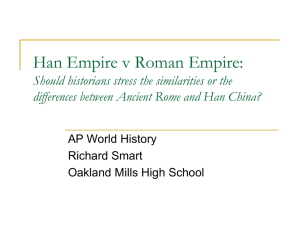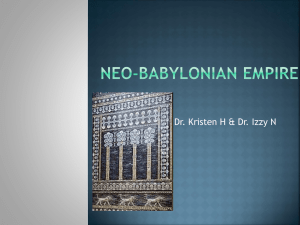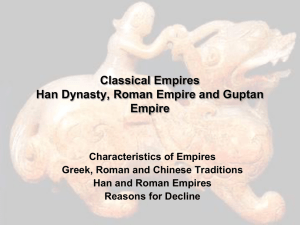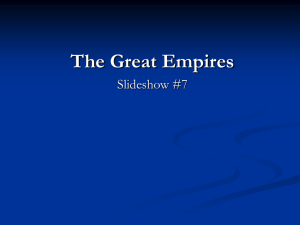Ch 4 Powerpoint - Auburn High School
advertisement
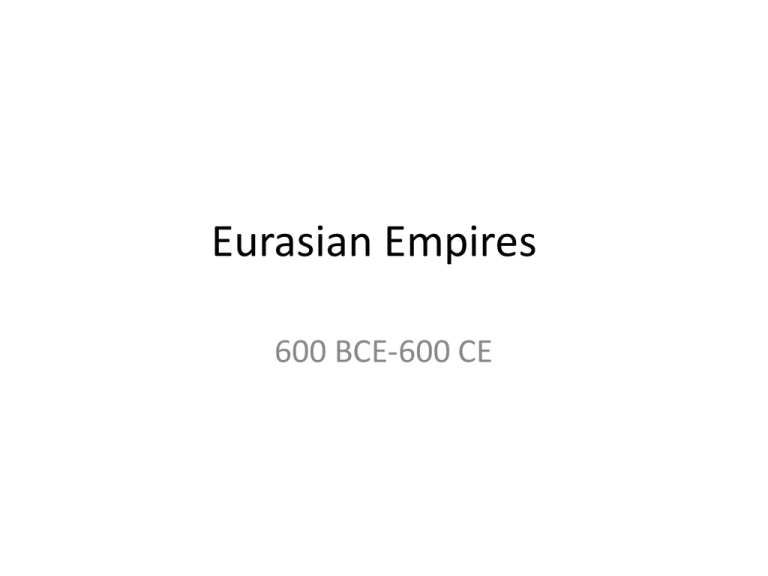
Eurasian Empires 600 BCE-600 CE How did Persian and Greek civilizations differ in their political organization and values? • • • • • • • • • The Persians built an imperial political system that drew upon previous Mesopotamian polities, including the Babylonian and Assyrian empires. The Persian Empire was far larger than its predecessors, stretching from Egypt to India, and ruled over some 35 million subjects. The Persian system was centered on an elaborate cult of kingship in which the emperor was secluded in royal magnificence and was approachable only through an elaborate ritual. Persian emperors were considered absolute in their power and possessed a divine right to rule by the will of the Persian god Ahura Mazda. The Persian Empire was ruled through an effective administrative system that placed Persian governors, called satraps, in each of twentythree provinces, while lower-level officials were drawn from local authorities. This system was monitored by imperial spies. Persia’s rule of its many conquered peoples was strengthened by a policy of respect for the empire’s non-Persian cultural traditions. In contrast, Greek political organization was based on hundreds of independent city-states or small settlements of between 500 and 5,000 male citizens. The Greeks did not build an empire but did expand through the establishment of colonies around the Mediterranean and Black seas. The most distinctive feature of Greek political culture lay in the extent of popular participation in political life that occurred within the citystates. This participation was based on the unique ideas of “citizenship,” of free people running the affairs of state, and of equality for all citizens before the law. Political participation in Greek city-states was much wider than in Persia, but it varied considerably between citystates and over time. Early in Greek history, only the wealthy and wellborn had the rights of full citizenship, but middle- and lower-class men gradually obtained these rights in some city-states. Nowhere was participation universal. The widest participation occurred in Athens beginning in 594 B.C.E., when the reforming leader Solon took Athenian politics in a more democratic direction, breaking the hold of a small group of aristocratic families. Debt slavery was abolished, access to public office was opened to a wider group of men, and all citizens were allowed to take part in the Assembly. Later, all holders of public office were chosen by lot and were paid, so that even the poorest could serve. Athenian democracy was direct rather than representative. Even at its height, it was far from universal, with well over half the population, including women, slaves, and foreigners, excluded from participation. 2. Why did semidemocratic governments emerge in some of the Greek city-states? • • Growing numbers of men were able to afford the armor and weapons that would allow them to serve in the armies of the city-states. • • In many places, dictators known as tyrants emerged for a time, usually with the support of the poorer classes, to challenge the prerogatives of the wealthy. One example is the Athenian leader Solon, who emerged in 594 B.C.E. During his rule, he broke the hold on power of a small group of aristocratic families in Athens. At the same time, he abolished debt slavery, increased access to public office to a wider group of men, and allowed all citizens to take part in the Assembly. 3. What were the consequences for both sides of the encounter between the Persians and the Greeks? • • • • • • While no doubt embarrassing, the failure of the Persian invasions of Greece had very little impact on the Persian Empire. Defeat of the Persian armies was a source of enormous pride for Greece. For the Greeks (especially the Athenians), it confirmed their view that Greek freedoms strengthened their will to fight, while Persia came to represent despotism. This view persisted into the twentieth century in European thinking in the notion of an East/West divide in which Europe (the West) represented freedom and Asia (the East) represented despotism. Greek victory radicalized Athenian democracy, because service by poorer Athenians as rowers in the navy placed them in a position to insist on full citizenship. The fifty years following the Greco-Persian Wars were the high point for participation in Athenian democracy. The fifty years following the defeat of the Persians also witnessed the Golden Age of Greek (and especially Athenian) culture, a period when monumental buildings like the Parthenon in Athens were built, Greek theater was born, and Socrates was beginning his career as a philosopher. But the Greco-Persian Wars also led to an era of incipient empire. After the war, Athens tried to solidify its dominant position among the Greeks who had allied against Persia, and this led to intense resentment and finally to a bitter civil war known as the Peloponnesian War. Athens was defeated, while the Greeks exhausted themselves and magnified their distrust of one another. This infighting ultimately opened the way for Macedonia to conquer the Greek city-states. 4. What changes did Alexander’s conquests bring in their wake? • Alexander’s conquests led to the widespread dissemination of Greek culture into Egypt, Mesopotamia, and India. The major avenue for this spread lay in the many cities established by the Greeks throughout the Hellenistic world. 5. How did Rome grow from a single city to the center of a huge empire? • • • • • • • • • The values of the Roman republic, including rule of law, the rights of citizens, absence of pretension, upright moral behavior, and keeping one’s word—along with a political system that offered some protection to the lower classes—provided a basis for Rome’s empire-building enterprise. Victory in the Punic Wars with Carthage (264–146 B.C.E.) extended Roman control over the western Mediterranean and made Rome a naval power. As the empire grew, each addition of territory created new vulnerabilities that drove further conquests. Poor soldiers hoped for land, loot, or salaries. The well-to-do or well-connected gained great estates, earned promotion, and sometimes achieved public acclaim and high political office by participating in empire building. The wealth of long-established societies in the eastern Mediterranean spurred Roman conquests, as did the resources and food supplies of the less developed western Mediterranean. Rome’s central location in the Mediterranean basin made empire building easier. Rome’s army was a key to its success. It was drawn from the growing population of Italy and was renowned for being well trained, well fed, and well rewarded. As the empire grew, so did political support in Rome for its continued expansion. This ensured that the necessary manpower and resources were committed to empire building. 6. How and why did the making of the Chinese empire differ from that of the Roman Empire? • Unlike the Roman Empire (which was new), the Chinese empire represented an effort to revive an imperial tradition that already existed under the Xia, Shang, and Zhou dynasties. Because of the preexisting imperial tradition in China, the process of creating the empire was quicker, though it was no less reliant on military force and no less brutal than the centurieslong Roman effort. • Unlike Rome’s transition from republic to empire, the creation of the Chinese empire had only brief and superficial domestic repercussions. 7. In comparing the Roman and Chinese empires, which do you find more striking—their similarities or their differences? • • • • • • The Roman and Chinese empires shared many common features, though they did also differ in important ways. In general, the Chinese empire was able to foster greater cultural homogeneity and more centralized political control than did its Roman counterpart. Both defined themselves in universal terms. Both invested heavily in public works designed to integrate their respective domains militarily and commercially. Both invoked supernatural sanctions to support their rule. Both absorbed foreign religious traditions, though the process unfolded somewhat differently. In the case of Rome, Christianity was born as a small sect of a small province in a remote corner of the empire. From there, it spread slowly for several centuries, mostly among the poor and lower classes, suffering from intermittent persecution. In the fourth century C.E., it obtained state support from the emperors and thereafter spread quite rapidly, becoming the dominant religious tradition throughout Europe in the centuries after the fall of Rome. In the case of China, Buddhism came from India, far beyond the Chinese world. It was introduced by Central Asian traders and received little support from Chinese rulers until the Sui dynasty emperor Wendi (589–618 C.E.). Even then it became only one of several religious strands in a complex Chinese mix. • The Roman and Chinese empires also had a different relationship to the societies that they governed. • The Romans ruled as a distinct minority within the empire. Over time, the empire did assimilate conquered peoples by granting them Roman citizenship for service to the empire or in recognition of their adoption of Roman culture. In 212 C.E., Roman citizenship was bestowed on all free people of the empire. The Chinese empire, by contrast, grew out of a much larger cultural heartland that was already ethnically Chinese. • Moreover, as the Chinese empire expanded to the south, it actively assimilated non-Chinese people. • The Roman Empire assimilated more cultural traditions, with Roman and Greek culture freely mixing and other non-Roman cultural traditions—including the cult of the Persian god Mithra, the cult of the Egyptian goddess Isis, and the Judaism-derived religion of Christianity—spreading throughout the empire. In China, with the exception of Buddhism, Chinese culture was widely recognized as the model to which others should conform. It experienced little competition from an older, venerated, or foreign tradition. • Language served the two empires in important but contrasting ways. Latin, an alphabetic language depicting sounds, gave rise to distinctive languages— Spanish, Portuguese, French, Italian, Romanian. Chinese did not, in part because Chinese written characters, which represented words or ideas more than sounds, were not easily transferable to other languages. But written Chinese could be understood by all literate people no matter which spoken dialect of the language they used. So Chinese, more than Latin, served as an instrument of elite assimilation. • Politically, both empires established effective centralized control over vast regions and huge populations. • But the Chinese, far more than the Romans, developed an elaborate bureaucracy to hold the empire together. • The Chinese relied on a civil service system, complete with examinations and selection by merit; the Romans relied more on regional elites and the army to provide cohesion. The Romans, though, unlike the Chinese, developed an elaborate body of law applicable equally to all people of the realm. 8. How did the collapse of empire play out differently in the Roman world and in China? • • • While the Han Empire came to an end in 220 C.E., only the western half of the Roman Empire collapsed, leaving the eastern half (subsequently known as the Byzantine Empire) to maintain the tradition of imperial Rome for another thousand years. Nomadic or semi-agricultural peoples occupying the frontier regions of both empires became growing threats that ultimately conquered portions of both empires. However, the nomads who successfully invaded and settled in north China assimilated culturally, while the nomads who invaded and settled in Western Europe developed their own ethnic identities, even as they drew on Roman law and adopted Roman Christianity. Thus, the collapse of the western portion of the Roman Empire produced greater cultural changes that ultimately provided the foundation for the hybrid Latin and Germanic civilization that would arise in Western Europe. The most significant difference between the collapse of the Roman world and the Chinese world is that, after 350 years, a Chinese imperial state was reassembled under the Sui (589–618 C.E.), Tang (618–907 C.E.), and Song (960–1279 C.E.) dynasties. In the western part of the Roman Empire, no large-scale, centralized, imperial authority, encompassing all of Western Europe, has ever been successfully reestablished for any length of time. 9. Why were centralized empires so much less prominent in India than in China? • Indian empires failed to command the kind of loyalty or exercise the degree of influence that Chinese empires did. • India’s unparalleled cultural diversity made a centralized empire less easy to construct than in more culturally united China. • The frequency of invasions from Central Asia in comparison to China also made centralized empire less likely, because Indian states, which otherwise might have provided the nucleus for an all-India empire, were repeatedly smashed by invaders. • In contrast to the situation in China, India’s social structure, embodied in a caste system linked to occupational groups, made for intensely local loyalties at the expense of wider identities that might have fostered empires. BP:10. What common features can you identify in the empires described in this chapter? • All empires controlled large areas and populations. • All empires were brought together by conquest and funded in part by extracting wealth from conquered peoples. • All empires stimulated the exchange of ideas, cultures, and values among the peoples they conquered. • All empires sought to foster an imperial identity that transcended more local identities and loyalties. • All empires ultimately collapsed. BP: 11. In what ways did these empires differ from one another? What accounts for those differences? • Some empires sought to rule through local elites; other empires sought to rule with a more centralized power structure. • Some empires were new; others drew on older traditions. • Some empires lasted for considerably longer periods than others. • Some empires assimilated conquered peoples more quickly and completely than others. BP:12. Are you more impressed with the “greatness” of empires or with their destructive and oppressive features? Why? • This question can reasonably be answered either way: • Empires were impressive because of the impact they had on regions that they conquered; their sheer size and the number of subjects over which they ruled; their military conquests; and their monumental architecture, often associated with the promotion of political authority. • Their use of force in the creation of empires and their use of coercion to extract resources, particularly from conquered peoples, offer a strong argument that they were destructive and oppressive. BP:13. Do you think that the classical empires hold “lessons” for the present, or are contemporary circumstances sufficiently unique as to render the distant past irrelevant? • This question can be answered successfully from several perspectives, although in order to argue that the classical empires are irrelevant a student would have to address the arguments made in the Reflections section of the text. • A student might focus on the cultural memory of empires being used in the modern world. The Reflections section offers examples of Mao Zedong, the modern Indian nonviolence movement, the British imperial education system, and Mussolini all using the examples of previous empires as models for their own societies. • As prompted by the opening and closing sections of the chapter, a student might draw potential lessons for the United States today, especially from the model of Rome, whose conquests led to a political shift from a republican to an imperial political system. • A student could also argue that basic problems of classical empires, such as overextension and the creation of a unified identity that redefines conquered peoples, are timeless issues still relevant today.

